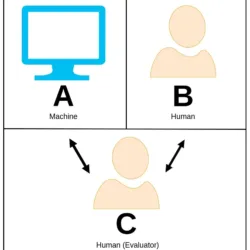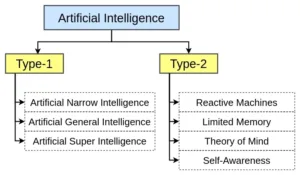Artificial Intelligence (AI) has been improving and plays a vital role in our daily lives. One of the most popular tests for determining the intelligence of a machine is the Turing Test, proposed by Alan Turing in 1950. However, the Turing Test has faced criticism, one of which is the Chinese Room Test proposed by philosopher John Searle in 1980. In this article, we will delve into the details of the Turing Test and its criticisms, with a particular focus on the Chinese Room Test.
What is Turing Test
The Turing Test was proposed by British Mathematician and Computer Scientist Alan Turing in 1950 in his research paper “Computing Machinery and Intelligence”. It is used to determine a machine’s ability to exhibit intelligent behaviour equivalent or indistinguishable from that of a human being.
The test involves a human evaluator who engages in natural conversation with two entities: a human being and a machine. If the evaluator cannot reliably distinguish between a human and a machine, the machine is said to have passed the Turing Test and demonstrates intelligent behaviour.

For the purpose of the Turing Test, three rooms are selected. In one room there is an intelligent machine (A) and in the other two rooms, there are humans. One of the humans (C) is the evaluator who is supposed to ask questions from both the machine (A) and the human (B). The evaluator knows that there are two entities: a machine and a human, but does not know which one is a human and which one is a machine.
The conversation between the evaluator and the other two entities would be text-based via a terminal. So, if the evaluator could not reliably tell which one is a machine, then the machine is said to have passed the Turing Test.
The results of the Turing Test do not depend upon the machine’s ability to give correct answers, it depends upon how closely its answers resemble that of a human.
One of the criticisms of the Turing Test is the Chinese Room Test, developed by John Searle in the year 1980.
The Chinese Room Test
The Chinese Room Test also known as The Chinese Room Argument is a simple thought experiment that challenges the idea that the AI truly possesses the intelligence or merely simulates it.
The experiment involves a person without knowledge of the Chinese language being placed in a room with a dictionary containing instructions for manipulating Chinese symbols. A question in Chinese is sent via an input slot, and the person in the room uses the dictionary to manipulate the symbols to produce an answer, which is then passed to the outside world through an output slot.

From an outside perspective, it appears that the person inside the room understands Chinese and can answer questions competently. However, in reality, the person in the room does not understand the meaning of the Chinese symbols and is simply following rules from the dictionary. According to John Searle, this demonstrates that an intelligent computer program or machine only simulates human intelligence without truly understanding its meaning. The computer program simply follows a set of rules without understanding the language’s meaning.
One criticism of The Chinese Room Test is that the entire system, including the person inside the room, understands the Chinese language, despite the person’s lack of understanding. Ray Kurzweil, an AI researcher, argues that the person inside the room is a part of the whole system and its properties are not to be confused with the properties of the whole system.
Conclusion
In conclusion, the Turing Test and The Chinese Room Test are two important and controversial tests used to evaluate the intelligence of artificial intelligence. While the Turing Test has been widely used and recognized for its ability to determine if a machine can exhibit intelligent behaviour, it has also faced criticisms, such as the Chinese Room Test. The Chinese Room Test argues that machines can simulate human intelligence without truly understanding its meaning, as they are simply following a set of rules. However, there are also criticisms of the Chinese Room Test, such as the argument that the entire system, including the person inside the room, understands the language. These debates continue to shape our understanding and development of AI today.




